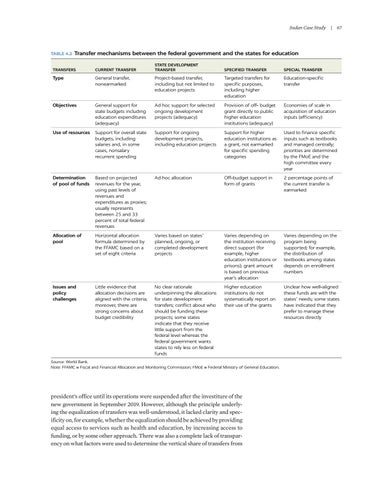Sudan Case Study | 67
TABLE 4.2 Transfer
mechanisms between the federal government and the states for education STATE DEVELOPMENT TRANSFER
TRANSFERS
CURRENT TRANSFER
SPECIFIED TRANSFER
SPECIAL TRANSFER
Type
General transfer, nonearmarked
Project-based transfer, including but not limited to education projects
Targeted transfers for specific purposes, including higher education
Education-specific transfer
Objectives
General support for state budgets including education expenditures (adequacy)
Ad hoc support for selected ongoing development projects (adequacy)
Provision of off- budget grant directly to public higher education institutions (adequacy)
Economies of scale in acquisition of education inputs (efficiency)
Use of resources
Support for overall state budgets, including salaries and, in some cases, nonsalary recurrent spending
Support for ongoing development projects, including education projects
Support for higher education institutions as a grant, not earmarked for specific spending categories
Used to finance specific inputs such as textbooks and managed centrally; priorities are determined by the FMoE and the high committee every year
Determination of pool of funds
Based on projected revenues for the year, using past levels of revenues and expenditures as proxies; usually represents between 25 and 33 percent of total federal revenues
Ad hoc allocation
Off-budget support in form of grants
2 percentage points of the current transfer is earmarked
Allocation of pool
Horizontal allocation formula determined by the FFAMC based on a set of eight criteria
Varies based on states’ planned, ongoing, or completed development projects
Varies depending on the institution receiving direct support (for example, higher education institutions or prisons); grant amount is based on previous year’s allocation
Varies depending on the program being supported; for example, the distribution of textbooks among states depends on enrollment numbers
Issues and policy challenges
Little evidence that allocation decisions are aligned with the criteria; moreover, there are strong concerns about budget credibility
No clear rationale underpinning the allocations for state development transfers; conflict about who should be funding these projects; some states indicate that they receive little support from the federal level whereas the federal government wants states to rely less on federal funds
Higher education institutions do not systematically report on their use of the grants
Unclear how well-aligned these funds are with the states’ needs; some states have indicated that they prefer to manage these resources directly
Source: World Bank. Note: FFAMC = Fiscal and Financial Allocation and Monitoring Commission; FMoE = Federal Ministry of General Education.
president’s office until its operations were suspended after the investiture of the new government in September 2019. However, although the principle underlying the equalization of transfers was well-understood, it lacked clarity and specificity on, for example, whether the equalization should be achieved by providing equal access to services such as health and education, by increasing access to funding, or by some other approach. There was also a complete lack of transparency on what factors were used to determine the vertical share of transfers from






